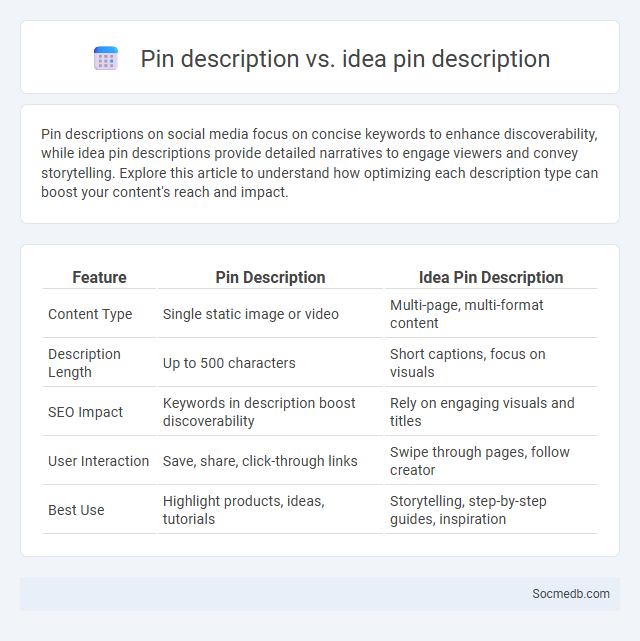
Photo illustration: pin description vs idea pin description
Pin descriptions on social media focus on concise keywords to enhance discoverability, while idea pin descriptions provide detailed narratives to engage viewers and convey storytelling. Explore this article to understand how optimizing each description type can boost your content's reach and impact.
Table of Comparison
| Feature | Pin Description | Idea Pin Description |
|---|---|---|
| Content Type | Single static image or video | Multi-page, multi-format content |
| Description Length | Up to 500 characters | Short captions, focus on visuals |
| SEO Impact | Keywords in description boost discoverability | Rely on engaging visuals and titles |
| User Interaction | Save, share, click-through links | Swipe through pages, follow creator |
| Best Use | Highlight products, ideas, tutorials | Storytelling, step-by-step guides, inspiration |
Understanding Traditional Pin Descriptions
Traditional pin descriptions on social media platforms like Pinterest play a crucial role in search engine optimization and user engagement by providing clear, keyword-rich text that accurately represents the pinned content. These descriptions should include relevant terms that reflect the image or video content, helping the pin appear in targeted search queries and improve visibility. Crafting concise, informative descriptions enhances click-through rates and drives traffic by aligning with both user intent and social media algorithms.
What Makes Idea Pin Descriptions Unique?
Idea Pin descriptions stand out by combining clear, keyword-rich text with step-by-step instructions that enhance discoverability on platforms like Pinterest. They integrate actionable language and hashtags to engage users and improve algorithmic ranking. This unique format encourages interaction by providing context and inspiration directly linked to visual content, making Idea Pins highly effective for social media marketing.
Pin Description vs. Idea Pin Description: Key Differences
Pin Descriptions on Pinterest primarily serve as concise, keyword-rich captions that enhance searchability and provide clear context for a single image or link. Idea Pin Descriptions, however, offer more detailed storytelling opportunities, supporting multi-page content with engaging, step-by-step narratives that drive higher user interaction. Understanding these differences is crucial for optimizing content visibility and engagement on Pinterest's platform.
SEO Optimization for Pin Descriptions
Pin descriptions optimized for SEO enhance visibility by integrating relevant keywords naturally within concise, engaging text that matches user search intent on platforms like Pinterest. Including specific terms related to the pin's content, such as trending topics or product features, increases the likelihood of appearing in search results and drives targeted traffic. Utilizing tags and hashtags strategically alongside descriptive language further boosts discoverability and improves overall social media marketing performance.
Crafting Engaging Idea Pin Descriptions
Crafting engaging Idea Pin descriptions on social media requires using clear, concise language that highlights the key benefits or features of your content to capture Your audience's attention quickly. Incorporate relevant keywords and hashtags naturally to boost searchability and increase the pin's visibility across platforms like Pinterest. Using a compelling call-to-action in Your description encourages users to interact, save, or share, enhancing overall engagement and reach.
Writing Effective Traditional Pin Descriptions
Writing effective traditional Pin descriptions on social media enhances visibility by incorporating relevant keywords and clear calls to action. Detailed descriptions help Pinterest's algorithm understand the Pin's content, increasing the chances of appearing in search results and related feeds. Including specific product details or benefits can drive higher engagement and click-through rates.
Character Limits and Best Practices
Character limits on major social media platforms vary, with Twitter allowing up to 280 characters, Instagram captions capped at 2,200 characters, and Facebook posts accommodating 63,206 characters. Optimal posts leverage concise messaging within limits to boost engagement and readability, using strategic hashtags, emojis, and clear calls-to-action. Understanding each platform's unique character constraints enhances content effectiveness and audience reach.
Enhancing Visibility: Pin Description Strategies
Crafting keyword-rich pin descriptions significantly boosts social media visibility by aligning content with user search intent and platform algorithms. Incorporating relevant hashtags and trending terms in pin descriptions improves discoverability and engagement rates. Optimizing descriptions with compelling calls-to-action encourages user interaction, further amplifying reach and brand presence.
Common Mistakes in Idea Pin vs. Pin Descriptions
Common mistakes in Idea Pin vs. Pin descriptions include neglecting keyword optimization, which reduces discoverability on platforms like Pinterest. Many users write overly vague or generic descriptions rather than using targeted, detailed language that aligns with search intent. To improve your content's visibility and engagement, ensure your Idea Pin and Pin descriptions are semantically rich and relevant to your audience's interests.
Boosting Pinterest Performance with Optimized Descriptions
Optimizing Pinterest descriptions with targeted keywords and compelling phrases enhances your content's visibility and engagement on the platform. Including relevant hashtags and clear calls-to-action in your descriptions encourages users to interact and share your pins. By refining your descriptions to match search intent, you can significantly boost your Pinterest performance and drive more traffic to your profile or website.
 socmedb.com
socmedb.com